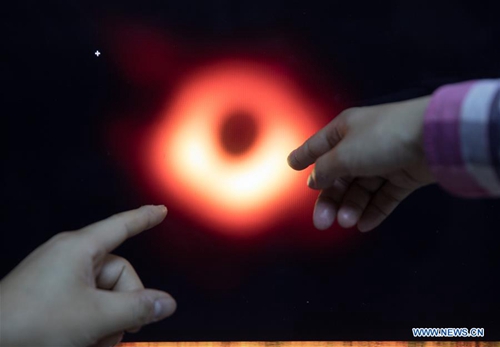HOME >> CHINA
China's space telescope opens new window to observe black holes
Source:Xinhua Published: 2019/10/27 12:50:41

Chinese researchers discuss the imaging methods of the image of a black hole in Shanghai Astronomical Observatory (SAO), in east China's Shanghai, April 9, 2019. The image of the black hole, based on observations through the Event Horizon Telescope (EHT), a planet-scale array of eight ground-based radio telescopes forged through international collaboration, was unveiled in coordinated press conferences across the globe at around 9:00 p.m. (Beijing time) on Wednesday. The landmark result offers scientists a new way to study the most extreme objects in the universe predicted by Albert Einstein's general relativity. (Photo:Xinhua)
China's first X-ray space telescope has helped scientists open a new window to observe and better understand bizarre celestial bodies like black holes and neutron stars.
The Hard X-ray Modulation Telescope (HXMT), dubbed Insight, sent into an orbit of 550 km above the Earth on June 15, 2017, has detected areas that are probably the closest to the black holes so far, shedding light on the basic properties of black holes and neutron stars and the behavior and radiation of matters near the strong magnetic and gravitational fields, said Lu Fangjun, deputy chief designer of the satellite.
The research team from the Institute of High Energy Physics of the Chinese Academy of Sciences announced some of the findings of the space telescope at the first China Space Science Assembly, which opened Saturday in Xiamen, east China's Fujian Province.
The satellite has conducted high precision and high-frequency observations on the binary star systems formed by a black hole and a normal star, or a neutron star and a normal star. When the matter of the normal star, driven by the strong gravitation, falls into a black hole or neutron star, it is accelerated and heated during the process, emitting strong X-rays, said Lu.
"We call them X-ray binary systems, which are regarded as natural laboratories of extreme physical conditions," said Lu.
Scientists study many phenomena that they cannot replicate on Earth by observing such systems and might learn more about the characteristics of black holes and neutron stars from the X-rays.
The HXMT has found a quasi-periodic change of the high energy X-rays emitted by the matter near black holes and neutron stars, Lu said.
Compared with X-ray astronomical satellites of other countries, HXMT has a larger detection area, broader energy range and more effective working time. These give it advantages in observing black holes and neutron stars emitting bright X-rays, according to Lu.
During its over two-year operation in orbit, the telescope has conducted more than 1,000 observations, sending back 2TB of scientific data. The satellite was also used to search for gamma-ray bursts corresponding to gravitational waves and test pulsar navigation.
Posted in: SOCIETY,CHINA FOCUS